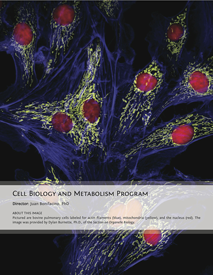You are here: Home > Cell Biology and Metabolism Program
Cell Biology and Metabolism Program
Director: Juan S. Bonifacino, PhD
Website: cbmp.nichd.nih.gov
The Cell Biology and Metabolism Program (CBMP) conducts research in various areas of molecular cell biology, including the mechanisms of intracellular protein traffic, organelle biogenesis, host-pathogen interactions, the biology of small non-coding RNAs and small proteins, the regulation of the cell cycle during oogenesis, and the structural and functional properties of integral membrane proteins. Knowledge gained from the study of basic cellular processes is applied to the elucidation of the causes of human diseases, including disorders of protein traffic as well as neurodegeneration and microbial pathogenesis.
The Unit on Structural and Chemical Biology of Membrane Proteins, headed by Anirban Banerjee, conducts atomic-level investigations into processes at the biological membrane. Broadly, the Unit is interested in both the mechanisms of action of several membrane proteins and the role of the surrounding lipid environment in modulating their structure and function. To approach these issues, members of the lab employ a combination of X-ray crystallography and solution-based biochemical and biophysical studies together with peptide and protein chemistry. As part of a global understanding of these processes, the Unit is currently pursuing two questions: how small peptidic toxins, which are components of animal venoms, interact with K+ channels; and the structural basis of the functions of mitochondrial inner-membrane transporters that are involved in iron homeostasis.
The Section on Intracellular Protein Trafficking, led by Juan Bonifacino, focuses on the molecular machinery involved in protein sorting to endosomes, lysosomes, lysosome-related organelles, and various domains of the plasma membrane (i.e., polarized sorting) and on the diseases that result from dysfunction of this machinery. Research over the past year elucidated the role of clathrin and the adaptor protein 1 (AP-1) complex in sorting of transmembrane receptors to the somato-dendritic domain of hippocampal neurons. In addition, the Section uncovered the structural mechanism by which the small GTPase Arf1 both recruits the AP-1 complex to membranes and activates it for recognition of sorting signals. Additional structural analyses revealed the mechanisms of signal recognition by the related AP-3 complex. In a further project, in vitro reconstitution analyses showed that transmembrane domain interactions between the Vpu protein of HIV-1 and the host cell co-receptor CD4 promote CD4 polyubiquitination through a combination of increased ubiquitination and decreased deubiquitination.
The Section on Gamete Development, led by Mary Lilly, examines cell-cycle regulation during oogenesis. Over the past year, the Section explored how metabolism influences meiotic progression and gamete differentiation. From these studies, members of the Section determined that the multiprotein SEA/GATOR complex defines a new upstream module of TORC1 regulation that controls meiotic progression and oocyte growth. Specifically, they elucidated opposing functions for the SEA/GATOR–complex components Npr2/Npr3 and Mio/Seh1 in the regulation of TORC1 activity during Drosophila oogenesis. Furthermore, they characterized three additional components of the SEA/GATOR complex and determined how these proteins influence both TORC1 signaling and meiotic progression in the female germline.
Jennifer Lippincott-Schwartz's Section on Organelle Biology continued to investigate cellular processes by using novel fluorescence imaging approaches combined with quantitative analysis and mathematical modeling. Among the areas of investigation were: (1) mitochondrial regulation of cell polarization; (2) cell-shape control by cellular adherence and contractile systems; (3) autophagy's role(s) in ensuring cell survival and longevity during starvation; (4) Rab10 and myosin-Va mediation of insulin-stimulated GLUT4 storage vesicle translocation in adipocytes; (5) primary cilia utilization of glycoprotein-dependent adhesion mechanisms to stabilize long-lasting cilia-cilia contacts; (6) endoplasmic reticulum (ER) stress–dependent clearance of misfolded GPI–anchored proteins from the ER; (7) computational modeling of cytokinetic abscission driven by ESCRT-III polymerization; (8) super-resolution analysis of HIV-1 formation and budding; (9) plasticity of the asialoglycoprotein receptor deciphered by ensemble FRET imaging and single-molecule–counting PALM imaging; (10) tool development for accelerating image reconstruction during Bayesian analysis of single-molecule fluorescence blinking/bleaching; and (11) spatial analysis of PALM datasets to analyze complex patterns of protein organization at the plasma membrane.
The Unit on Microbial Pathogenesis, headed by Matthias Machner, analyzes host-pathogen interactions during Legionnaires' disease, a potentially fatal pneumonia caused by the bacterium Legionella pneumophila. Of particular interest are bacterial proteins, so-called effectors, that are delivered into the host cell cytosol, where they alter signaling processes in order to create conditions favorable for the survival and replication of the pathogen. The Unit continued its in-depth analysis of the bacterial infection cycle by identifying novel host targets for translocated effectors and determining their importance for Legionella virulence. By chemically modifying Rab proteins, small GTPases that function as key regulators of vesicle traffic in eukaryotic cells, major progress was made in the characterization of effectors that exploit intracellular cargo transport.
The Section on Environmental Gene Regulation, headed by Gisela Storz, studies small, regulatory RNAs in E. coli. Many of these bacterial RNAs act analogously to eukaryotic miRNA and siRNAs to regulate mRNA stability and translation. In addition to identifying further small RNAs and characterizing their functions, the Section helped develop general tools for the study of the RNA regulators. The Section also pursues a project to identify and characterize another category of largely overlooked genes that encode small proteins of less than 50 amino acids. Systematic screens for growth conditions that lead to increased expression and for phenotypes associated with null mutations, combined with the identification of copurifying proteins, are yielding insights into the physiological roles of these small proteins, such as the regulation of a major drug-efflux pump.


